▼ Minuteman III - New missile launched by US [04-28-17]
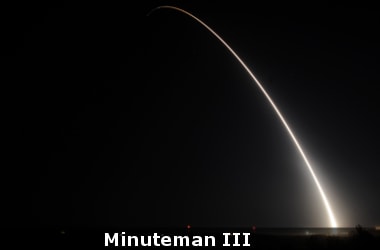 An unarmed intercontinental ballistic missile was launched during an operational test from an air base in the state of California, amid growing tensions on the Korean Peninsula. An unarmed intercontinental ballistic missile was launched during an operational test from an air base in the state of California, amid growing tensions on the Korean Peninsula.
The Minuteman III intercontinental ballistic missile equipped with a single test re-entry vehicle was launched on 26th April 2017 by a combined team of United States Air Force Global Strike Command Airmen.
According to US Air Force, the ICBM’s re-entry vehicle, which contained a telemetry package used for operational testing, travelled to the Kwajalein Atoll in the Marshall Islands, approximately 4,200 miles away from the launch site.
The ICBM test launch program demonstrates the operational credibility of the Minuteman III.
It also ensures the US ability to maintain a strong, credible nuclear deterrent as a key element of national security and the security of allies and partners.
The Minuteman III is one of three legs of the US nuclear triad, which also comprises strategic bombers such as the B-52 Stratofortress and B-2 Spirit, as well as submarine launched ballistic missions, provided by Navy submarines.
Though US Air Force Global Strike Command routinely conducts ICBM test launches from Vandenberg, the latest is still a great concern amid heightened tensions between the United States and the Democratic People’s Republic of Korea.
Minuteman III: Know More
- Unit cost : $7,000,000
- Guidance system : Inertial
- Warhead : Nuclear: W62, W78, or (from 2006) W87
- Launch platform : Missile Silo (MLCC)
|
▼ Now, MIT scientists 3D print entire building! [04-28-17]
 MIT scientists have designed a new robotic system that can 3D print the basic structure of an entire building, an advance that would make building houses a faster, less expensive process. MIT scientists have designed a new robotic system that can 3D print the basic structure of an entire building, an advance that would make building houses a faster, less expensive process.
The building could be completely customised to the needs of a particular site and the desires of its maker. Even the internal structure could be modified in new ways.
Different materials could be incorporated as the process goes along.
The material density could be varied for optimum combinations of strength, insulation, or other properties.
Ultimately, this approach could enable the design and construction of new kinds of buildings that would not be feasible with traditional building methods.
The system consists of a tracked vehicle that carries a large, industrial robotic arm, which has a smaller, precision-motion robotic arm at its end.
This highly controllable arm can then be used to direct any construction nozzle.
|
▼ Iceball planet discovered [04-28-17]
 Scientists have discovered a new planet with the mass of Earth, orbiting its star at the same distance that we orbit our sun. Scientists have discovered a new planet with the mass of Earth, orbiting its star at the same distance that we orbit our sun.
The planet is likely far too cold to be habitable for life as we know it, however, because its star is so faint.
But the discovery adds to scientists' understanding of the types of planetary systems that exist beyond our own.
This 'iceball' planet is the lowest-mass planet ever found through microlensing.
The newly discovered planet, called OGLE-2016-BLG-1195Lb, aids scientists in their quest to figure out the distribution of planets in our galaxy.
An open question is whether there is a difference in the frequency of planets in the Milky Way's central bulge compared to its disk, the pancake-like region surrounding the bulge.
OGLE-2016-BLG-1195Lb is located in the disk, as are two planets previously detected through microlensing by NASA's Spitzer Space Telescope.
For the new study, researchers were alerted to the initial microlensing event by the ground-based Optical Gravitational Lensing Experiment (OGLE) survey, managed by the University of Warsaw in Poland.
KMTNet consists of three wide-field telescopes: one in Chile, one in Australia, and one in South Africa.
Although OGLE-2016-BLG-1195Lb is about the same mass as Earth, and the same distance from its host star as our planet is from our sun, the similarities may end there.
OGLE-2016-BLG-1195Lb is nearly 13,000 light-years away and orbits a star so small, scientists aren't sure if it's a star at all.
Alternatively, it could be a brown dwarf or ultra-cool dwarf star much like TRAPPIST-1, which Spitzer and ground-based telescopes recently revealed to host seven Earth-size planet
Ground-based telescopes available today are not able to find smaller planets than this one using the microlensing method.
A highly sensitive space telescope would be needed to spot smaller bodies in microlensing events.
NASA's upcoming Wide Field Infrared Survey Telescope (WFIRST), planned for launch in the mid-2020s, will have this capability.
What is Microlensing?
- Microlensing is a technique that encourages the discovery of distant objects by using background stars as flashlights.
- When a star crosses accurately in front of a bright star in the background, the gravity of the foreground star focuses the light of the background star, making it appear brighter.
- A planet orbiting the foreground object may lead to an additional blip in the star’s brightness. In this case, the blip only lasted a few hours.
- This technique has discovered the most distant known exoplanets from Earth, and can detect low-mass planets that are substantially farther from their stars than Earth is from our sun.
|
▼ Scientists create first artificial womb [04-28-17]
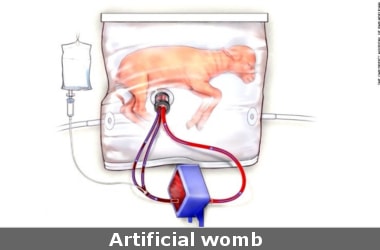 Researchers have created a fluid-filled transparent container called the Biobag to simulate how foetuses float in amniotic fluid inside the uterus of their mothers. Researchers have created a fluid-filled transparent container called the Biobag to simulate how foetuses float in amniotic fluid inside the uterus of their mothers.
Researchers tested five lambs with a biological age corresponding to 23-week human premature babies in the artificially created womb like device.
The premature lambs were delivered by C-section and were immediately placed into the womb-like device.
To replicate a womb, researchers created a temperature-controlled bag filled with a substitute for amniotic fluid.
They used an electrolyte solution to mimic amniotic fluid that the lambs swallow and take into their lungs.
The researchers then attached the umbilical cord to the device that exchanges carbon dioxide in blood with oxygen.
After four weeks, the lambs were seen opening their eyes, started growing wool, breathe and swim
This womb can help in development of premature babies in a uterus-like environment.
The womb-like environment will offer them a better chance of healthy survival.
At present, the premature babies are hooked to ventilators and other machines inside incubator and are at risk for serious disabilities such as cerebral palsy.
|
▼ World's oldest fungus discovered [04-28-17]
Scientists have discovered what maybe the world's oldest fungus in South African rocks dating back 2.4 billion years.
The fossils suggest that fungus may have evolved from under the deep sea rather than land.
Drilled from rocks that were once beneath the seafloor, the fossils resemble living fungi and could push back the date for the oldest fungi by one to two billion years.
If not a fungus, the organism could be from an extinct branch of life that has not been described before.
The deep biosphere where the fossils were found represents a significant portion of the Earth, but we know very little about its biology and even less about its evolutionary history.
The fossils closely resemble those found in similar conditions on land.
They are made up of jumbles of tangled threads some hundredths of a millimetre thick.
There is a "clear possibility" that they are the world's oldest fossil fungi - twice as old as generally accepted in the fossil record.
The fossils were collected by drilling into ancient rock formed from lava that was once beneath the sea bed in what is now South Africa
Known as the Ongeluk Formation, the location was underwater at the time the organisms would have been alive, researchers said. The fungi may have colonised cavities of rock deep beneath the sea floor.
|
▼ NASA launches stadium sized balloon [04-27-17]
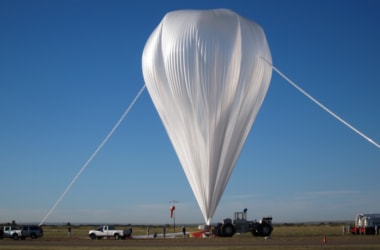 A stadium-sized pressure balloon launched by NASA in New Zealand began collecting data in near space on 26th April 2017. A stadium-sized pressure balloon launched by NASA in New Zealand began collecting data in near space on 26th April 2017.
This is beginning a 100-day planned journey after several launch attempts were thwarted by storms and cyclones.
The balloon, designed by the National Aeronautics and Space Administration to detect ultra-high energy cosmic particles from beyond the galaxy as they penetrate the earth’s atmosphere, is expected to circle the planet two or three times.
The balloon’s monitoring was only the start of a long quest which would next involve a space mission currently being designed by NASA, she added.
The balloon, launched on 24th April 2017 in Wanaka, a scenic spot on New Zealand’s South Island, will collect data from 34 km above the earth.
New Zealand was also the base for NASA’s scientific balloon programme in 2015 and 2016.
New Zealand: Know More
- New Zealand is a country in the southwestern Pacific Ocean.
- It is consisting of 2 main islands, both marked by volcanoes and glaciation.
- Capital Wellington, on the North Island, is home to Te Papa Tongarewa, the expansive national museum.
- Capital: Wellington
- Code: +64
- Currency: New Zealand dollar
- Prime minister: Bill English
- Population: 4.596 million (2015) World Bank
|
▼ China's first aircraft carrier indigenously built launched [04-27-17]
 China has launched its first indigenously built aircraft carrier following the 68th-anniversary celebrations of the founding of the Chinese navy. China has launched its first indigenously built aircraft carrier following the 68th-anniversary celebrations of the founding of the Chinese navy.
It is China’s second aircraft carrier built in the north-eastern port of Dalian.
The new aircraft carrier will be able to operate China’s Shenyang J-15 fighter jets and will be more dedicated to military and humanitarian operations.
The design of the new aircraft carrier has been obtained from China’s first aircraft carrier, the Liaoning, which was bought second-hand from Ukraine in 1998 and refitted in China.
As per the foreign military analysts, the presence of two aircraft carriers has made China the most powerful maritime force in the Asia-Pacific.
What is a Blue Water Navy in China?
- A blue-water navy is a maritime force having the capability to operate globally across the deep waters of open oceans.
- China has the second largest military budget in the globe.
- Although, the design of China’s aircraft carriers would give its fighter jets enough lift to take off from their shorter decks, they lack the powerful catapult technology for launching aircraft as seen in US navy’s longer-range nuclear carriers.
- With China’s claims of almost all the South China Sea in which other countries like Brunei, Malaysia, the Philippines, Taiwan and Vietnam also have claims, experts feel that the country will need at least six carriers.
- The United States operates 10 aircraft carriers and plans to build two more carriers in the future.
|
▼ SII now world's largest injectable polio vaccine manufacturer [04-26-17]
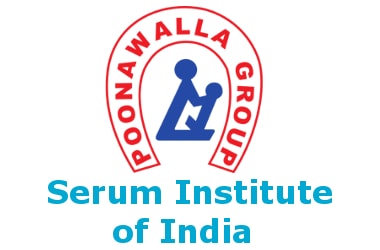 Cyrus Poonawala led Serum Institute of India Pvt. Ltd. (SII), world's largest vaccine manufacturer by number of doses produced and sold globally, has acquired Czech Republic based biopharmaceutical development and manufacturing firm Nanotherapeutics. Cyrus Poonawala led Serum Institute of India Pvt. Ltd. (SII), world's largest vaccine manufacturer by number of doses produced and sold globally, has acquired Czech Republic based biopharmaceutical development and manufacturing firm Nanotherapeutics.
The acquisition is for 72 million Euro, making SII the largest injectable Polio vaccine manufacturer in the world.
This acquisition will add to SII group injectable Polio capacity, increasing it by 4 times to a total of 200 million doses by 2019. We will be investing another 45 million Euros in upgrading the facility.
The company is also building a greenfield facility in Pune with investments of INR 2000 crore to further consolidate it global positioning in the sector.
Nanotherapeutics has manufacturing capabilities for biologic products that will provide the department of defence and US government with ability to rapidly respond to emerging disease threats and chemical, biologic, radiological and nuclear events.
The current acquisition by the company is the second one overseas since 2012 when it bought a plant in Holland.
SII: Know More
- SII, Pune is currently one of the largest manufacturers of MMR group of vaccines and Pentavalent group of vaccines in the world.
- It is present in 147 countries.
- With manpower of 5000 employees in SII, Pune, the company plans to add around 200 employees in the next 2-3 years in Czech Republic.
|
▼ Google Translate using neural machine translation technology [04-26-17]
 Google unveiled a new set of products and features for Indian languages to better serve the needs of Indians who were coming online rapidly. Google unveiled a new set of products and features for Indian languages to better serve the needs of Indians who were coming online rapidly.
Google Translate will use a new ‘neural machine translation technology’ to translate between English and nine widely-used Indian languages. These include Tamil, Kannada, Malayalam and Telugu. Other languages are Hindi, Punjabi, Bengali, Marathi and Gujarati.
The firm indicated neural translation offered a huge improvement over the old phrase-based system, translating full sentences at a time instead of pieces of a sentence.
This change improves the quality of translation in a single jump than seen in the last ten years combined.
Sharing insights from the joint report “Indian Languages - Defining India’s Internet” - by Google and consulting firm KPMG India, the company stated the country had 234 million Indian language users who were online compared with 175 million English web users.
Google aims for another 300 million Indian language users to come online in the next four years.
The extension of neural machine translation to Chrome browser’s built-in auto-translate functionality to web content would make full-page translations more accurate and easier to read.
The content ranges from song lyrics to cricket discussions.
The new translation capability will also be available to users on Google search and Maps to aid discovery of new places such as cafes and hotels with translations of local reviews on Google Maps, both on mobile and desktop.
Extending support to cover all 22 scheduled Indian languages, Google also rolled out new Gboard, a keyboard for Android unveiled in launched in December 2016.
It has transliteration support for languages.such as Urdu, Tamil, Hindi and Bengali.
With Google Search built right into the keyboard, Gboard will allow users to ‘search’ and use Google Translate right on their keyboard.
For users who often switch back and forth between Hindi and English, they will also be able to use ‘Hinglish’ language option with new text editing tool.
|
▼ Land attack Brahmos launched successfully [04-25-17]
 The Indian Navy successfully test- fired the land-attack version of Brahmos supersonic cruise missile on 21st April, 2017. The Indian Navy successfully test- fired the land-attack version of Brahmos supersonic cruise missile on 21st April, 2017.
The test-firing of the missile took place in the Bay of Bengal and it was very successful.
Land attack version of BrahMos supersonic cruise missile was fired for the first time from an Indian Navy’s stealth frigate, off the eastern coast, at a land target.
So, far only anti-ship version of BrahMos had been fired by Indian Navy.
Land Attack Brahmos: Know More
- The land-attack version of BrahMos has been operationalised in the Indian Army since 2007.
- The BrahMos missile, with a range of 290 km and a Mach 2.8 speed, is capable of being launched from land, sea and sub-sea pads against sea and land targets.
- BrahMos, jointly developed by India and Russia, is considered the only supersonic cruise missile in the world.
- The missile was first inducted in the India Navy in 2005. India is developing 450 km and 800 km range BrahMos missiles and an air launched version, designed to be delivered from Su-30 jets.
- It is also in the development phase.
|
▼ ISRO increases frequency of launch to 12 per year [04-25-17]
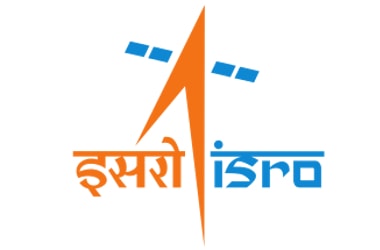 The Indian Space Research Organisation is trying to increase its capacity to deliver by scaling up the frequency of launches to 12 per year from the seven at present. The Indian Space Research Organisation is trying to increase its capacity to deliver by scaling up the frequency of launches to 12 per year from the seven at present.
This is building more satellites and lowering the cost of access to space.
ISRO is trying to go up to 8-9 PSLV per year, two GSLV-Mk II and one GSLV-Mk III. Total about 12 per year,.
ISRO is trying to increase its capacity to deliver by scaling up the frequency of launches by building more satellites, lowering the cost of access to space and also to do heavier satellite launches.
The space agency is in the process of constructing a second vehicle assembly building to improve the turnaround time and throughput for the PSLV so that with the same launch pad ISRO can do more launches, he said.
ISRO plans to undertake the Chandrayaan-2 mission in the first quarter of the next calendar year.
ISRO has identified its next steps in terms of air-breathing propulsion system.
|
▼ ISS American commander Whitson spends most time in space [04-25-17]
 The International Space Station's commander Peggy Whitson surpassed the record of 534 days, two hours and 48 minutes for most accumulated time in space by an American. The International Space Station's commander Peggy Whitson surpassed the record of 534 days, two hours and 48 minutes for most accumulated time in space by an American.
Whitson already was the world's most experienced spacewoman and female spacewalker and, at 57, the oldest woman in space.
By the time she returns to Earth in September, she'll have logged 666 days in orbit over three flights.
The world record, 879 days, is held by Russian Gennady Padalka.
Whitson broke the NASA cumulative record set last year by astronaut Jeffrey Williams; Scott Kelly holds the US record for consecutive days in space, 340.
Whitson is also the first woman to command the space station twice and the only woman to have led NASA's astronaut corps.
NASA astronaut Jack Fischer, who arrived at the space station last week and took part in Monday's call, said the space station is "by far the best example of international cooperation.''
Whitson told the president that spaceflight takes a lot of time and money, so getting to Mars will require collaboration from other countries to succeed.
NASA is building the hardware right now to test a new rocket that will carry astronauts farther from Earth than ever before, she said.
|
▼ ISRO launches solar energy app [04-25-17]
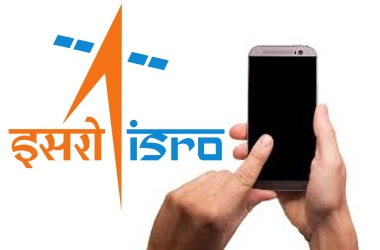 The Indian Space Research Organisation (ISRO) today said its Ahmedabad-based Space Applications Centre has developed an android app for computing the solar energy potential of a place. The Indian Space Research Organisation (ISRO) today said its Ahmedabad-based Space Applications Centre has developed an android app for computing the solar energy potential of a place.
Developed at the behest of the Union Ministry of New and Renewable Energy, the app is considered to be a "very useful" tool for installation of photovoltaic (PV) solar panels that is used for tapping solar energy.
The ISRO said the app provides monthly and yearly solar potential and the minimum and the maximum temperatures at any location.
It also displays the location of a place on the satellite image as well as the day's length there during different periods in a year.
According to ISRO, features of the app include providing of solar energy potential at any given location, the required location can be keyed in or can be obtained through GPS.
It said it also gives monthly and yearly solar potential processed using Indian Geostationary Satellite data (Kalpana- 1, INSAT-3D and INSAT-3DR), and also offers monthly minimum and maximum temperature to calculate the realistic solar potential.
The obstruction of sunlight due to terrain is also calculated using Digital Elevation Model (DEM) with the help of the app which also suggests optimum tilt angle for the solar PV installation
|
▼ HindRail, the mother of railway apps coming in June [04-24-17]
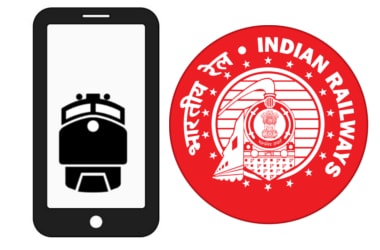 In June, train travel- related queries will be answered through one mega application, likely to be named HindRail, which incorporates in it most of the existing railways' apps. In June, train travel- related queries will be answered through one mega application, likely to be named HindRail, which incorporates in it most of the existing railways' apps.
The Indian Railways is developing the new app to work as a full-fledged inquiry system providing information on arrivals, departures, delays, cancellations, platform number, running status and berth availability.
Besides, it will also offer booking of taxis, porter services, retiring rooms, hotels, tour packages, e-catering and other travel-related needs.
IR will offer all these services on a revenue- sharing model with the service providers.
Thus, the app will serve as a revenue-earning platform for the public transporter and is slated to have a business potential INR 100 crore every year.
The new app will be launched in June and it will not only give you information, you can also track trains through it.
Currently, there are several apps operated by the Indian Railways which provide various kinds of services. These include the CMS App for complaint management system.
The National Train Enquiry System (NTES) app provides inquiry facility. There are apps for booking reserved and unreserved tickets. There is another app managed by the IRCTC for the e-catering services.
All these will be integrated in the proposed app.
Other suggested names were MeriRail, ERail, MyRail and Rail Anubhuti.
|
▼ Now, 3D object printing using glass possible! [04-24-17]
 Scientists have developed a novel way to 3D-print objects using glass, an advance that could be used to make very small optical components for complex computers. Scientists have developed a novel way to 3D-print objects using glass, an advance that could be used to make very small optical components for complex computers.
Researchers mixed nanoparticles of high-purity quartz glass and a small quantity of liquid polymer and allowed the mixture to be cured by light at specific points — by means of stereolithography.
The 3D-printed glass can be used for many applications, including data technology.
The next plus one generation of computers will use light, which requires complicated processor structures, 3D technology could be used, for instance, to make small, complex structures out of a large number of very small optical components of different orientations.
What Is Stereolithography?
- Stereolithography is a form of 3D-printing technology.
- It is used for creating models, prototypes, patterns and production parts in a layer by layer fashion
- It uses photo-polymerisation, a process by which light causes chains of molecules to link, forming polymers.
- The material, which remains a liquid, is washed out in a solvent bath, leaving only the desired cured structure.
- The polymer still mixed in this glass structure is subsequently removed by heating.
- A variety of 3D-printing techniques available so far have been used on polymers or metals, but rarely on glass.
- Where glass was processed into structures, for instance by melting and application by means of a nozzle, the surface turned out to be very rough, the material was porous and contained voids.
- Researchers presented a new method, an innovation in materials processing, in which the material of the piece manufactured is high-purity quartz glass with the respective chemical and physical properties.
- The glass structures show resolutions in the range of a few micrometres — one micrometre corresponding to one thousandth of a millimetre.
- However, the structures may have dimensions in the range of a few centimetres, researchers said.
|
▼ Tesla working to create brain-computer interface [04-24-17]
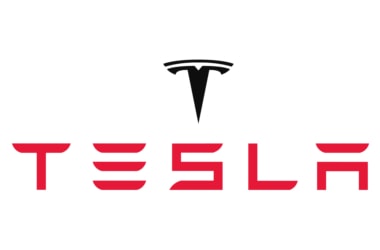 Tesla chief executive Elon Musk's Neuralink Corp is working to link the human brain with a machine interface by creating micron-sized devices. Tesla chief executive Elon Musk's Neuralink Corp is working to link the human brain with a machine interface by creating micron-sized devices.
Neuralink is aiming to bring to the market a product that helps with certain severe brain injuries due to stroke, cancer lesion etc, in about four years.
Artificial intelligence and machine learning will create computers so sophisticated and godlike that humans will need to implant "neural laces" in their brains to keep up.
There are a bunch of concepts in your head that then your brain has to try to compress into this incredibly low data rate called speech or typing.
If one has two brain interfaces, one could actually do an uncompressed direct conceptual communication with another person.
The technology could take about eight to 10 years to become usable by people with no disability, which would depend heavily on regulatory approval timing and how well the devices work on people with disabilities.
Tesla: Know More
- Industry: Automotive/Energy Storage
- Founded: July 1, 2003; (as Tesla Motors)Delaware, U.S.
- Founders: Elon Musk, JB Straubel, Martin Eberhard, Marc Tarpenning and Ian Wright
- Headquarters: Palo Alto, California, U.S.
- Area served: Worldwide
|
▼ New cause of blood pressure! [04-24-17]
 Scientists have discovered a new cause of high blood pressure which could lead to better ways of managing the disorder. Scientists have discovered a new cause of high blood pressure which could lead to better ways of managing the disorder.
High blood pressure, also known as hypertension, often goes unnoticed but if left untreated can increase the risk of heart attack and stroke.
However, it is known that in up to 10 per cent of hypertensive patients the overproduction of the adrenal hormone aldosterone, a condition known as primary aldosteronism or Conn syndrome, is the cause of disease.
Researchers found that a large number of patients with Conn syndrome do not only overproduce aldosterone but also the stress hormone cortisol.
Scientists have decided to name this new cause of hypertension–the combined overproduction of aldosterone and cortisol–as Connshing syndrome.
At present, many Conn syndrome patients are treated with drugs that are directed against the adverse effects of aldosterone.
However, this leaves the cortisol excess untreated, researchers said.
These previous studies had found increased rates of type 2 diabetes, osteoporosis and depression in Conn patients–problems typically caused by overproduction of cortisol, also termed Cushing syndrome, and not by too much aldosterone.
Patients will now need to undergo more detailed assessment to clarify whether they suffer from Conn or Connshing syndrome.
|
▼ Structure of this bacteria fights infections! [04-24-17]
Researchers have uncovered molecular details of how pathogenic bacteria fight back against the human immune response to infection.
Scientists at the University of East Anglia (UEA) and Institut de Biologie Structurale (CEA-CNRS-UGA, France) have identified the structure of NsrR.
This is a bacterial protein that binds to DNA and plays a key role in the bacterium’s resistance to nitric oxide (NO), which is produced in the initial immune response to infection.
In order to counter the effects of NO, which can be toxic to living organisms, many bacteria have evolved ways to detect it and mount a cellular response.
The most common dedicated NO sensor in bacteria is the regulatory protein NsrR. Regulatory proteins bind to DNA, and in doing so control whether particular genes are switched on or off.
|
▼ China's first unmanned cargo spacecraft Tianzhou-1 [04-21-17]
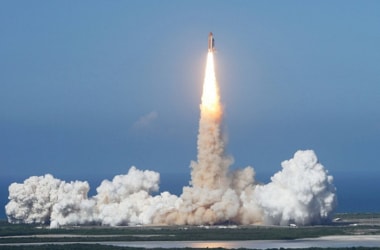 China has launched its first unmanned cargo spacecraft on a mission to dock with the space station of the country. China has launched its first unmanned cargo spacecraft on a mission to dock with the space station of the country.
The Tianzhou 1 blasted off on April 20, 2017 atop a latest-generation Long March 7 rocket from China's newest spacecraft launch site, Wenchang, on the island province of Hainan.
It is programmed to conduct scientific experiments after reaching the now crewless Tiangong 2, China's second space station.
China launched the Tiangong 2 precursor facility in September and the station's 20-ton core module will be launched next year.
The completed 60-ton station is set to come into full service in 2022 and operate for at least a decade.
Tiangong-2: Know More
- Launch date: 15 September 2016
- Orbital period: 1.5 hours
- Launch pad: Jiuquan LA-4/SLS-1
- Orbital inclination: 42.79°
- Orbital speed: 7.68 km/s (4.77 mi/s)
- Manufacturer: China National Space Administration
|
▼ Now, a robotic cheetah! [04-21-17]
 Scientists have developed a lightweight robotic cheetah. It efficiently uses its energy to replicate the movements of the fastest land animal in the world. Scientists have developed a lightweight robotic cheetah. It efficiently uses its energy to replicate the movements of the fastest land animal in the world.
The scaled-down robotic version moves using only about 15 per cent more energy than a real cheetah.
While walking robots tend to be large and heavy, taking cumbersome steps that use a lot of energy, the cheetah runs swiftly and smoothly.
The research provides valuable knowledge that can be used to optimise the robots of the future, designed to support us in areas such as healthcare or housekeeping.
The knowledge gained from the project can also be put to good use in rehabilitation robots or advanced prosthetics that are equipped with robotics.
The backbone proves crucial to the power this big cat generates. Bending and extending its spine enables the cheetah to move efficiently, run exceptionally fast and make huge leaps.
The main difference between existing walking robots and the cheetah robot is therefore the backbone.
Cheetahs are also able to store a lot of energy in their muscles for later use. This too is something one would have imitated by fitting carefully selected springs in our robot's legs.
The prototype weighs in at 2.5 kg and is 30 cm long–twenty times lighter than a real cheetah and four times smaller.
Taking into account the weight difference, the robot moves using only about fifteen per cent more energy than a real cheetah.
The robot can currently reach a speed of about one kilometre per hour.
|
▼ LHS 1140 exoplanet with possibility of life [04-21-17]
 Scientists have discovered a new Earth-like planet orbiting a red dwarf star about 40 light years away, which may be the best place yet to look for signs of life beyond the solar system. Scientists have discovered a new Earth-like planet orbiting a red dwarf star about 40 light years away, which may be the best place yet to look for signs of life beyond the solar system.
Using European Southern Observatory (ESO)'s HARPS instrument at La Silla, and other telescopes around the world, an international team of astronomers discovered the exoplanet orbiting in the habitable zone around the faint star LHS 1140.
This world is a little larger and much more massive than the Earth and has likely retained most of its atmosphere.
This, along with the fact that it passes in front of its parent star as it orbits, makes it one of the most critical future targets for atmospheric studies.
Red dwarfs are much smaller and cooler than the Sun.
Although the super-Earth LHS 1140b is ten times closer to its star than the Earth is to the Sun, it only receives about half as much sunlight from its star as the Earth and lies in the middle of the habitable zone.
The orbit is seen almost edge-on from Earth and as the exoplanet passes in front of the star once per orbit it blocks a little of its light every 25 days.
For life as we know it to exist, a planet must have liquid surface water and retain an atmosphere.
When red dwarf stars are young, they are known to emit radiation that can be damaging for the atmospheres of the planets that orbit them.
The planet's large size means that a magma ocean could have existed on its surface for millions of years.
This seething ocean of lava could feed steam into the atmosphere long after the star has calmed to its current, steady glow, replenishing the planet with water.
The astronomers estimate the age of the planet to be at least five billion years.
They also deduced that it has a diameter 1.4 times larger than the Earth - almost 18 000 kilometres.
However, with a mass around seven times greater than the Earth, and hence a much higher density, it implies that the exoplanet is probably made of rock with a dense iron core.
This super-Earth may be the best candidate yet for future observations to study and characterise its atmosphere, if one exists than Proxima b or TRAPPIST-1.
|
▼ ISRO, BHEL announce partnership [04-21-17]
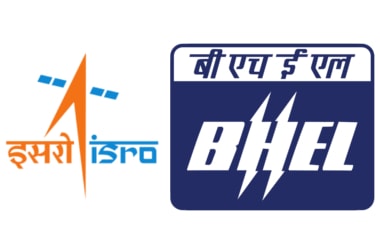 The Indian Space Research Organisation (ISRO) which is finalising a memorandum of understanding with BHEL to help develop low-cost lithium ion batteries for electric vehicles, also envisages a buyback commitment for such batteries. The Indian Space Research Organisation (ISRO) which is finalising a memorandum of understanding with BHEL to help develop low-cost lithium ion batteries for electric vehicles, also envisages a buyback commitment for such batteries.
The move is expected to take care of concerns on managing the waste generated at the end of battery life.
According to the MoU, BHEL will set up a production plant, while ISRO will provide support for scale-up, joint effort in cost optimisation, research and development for alternate chemistry and buyback commitment.
|
▼ Computers to now run on heat instead of electricity [04-20-17]
 Electronic systems do not work well in heat, apart from some exceptions. Heat is a normal byproduct of electricity. Researchers have evolved a thermal diode which is a computer component that runs on heat instead of electricity. Electronic systems do not work well in heat, apart from some exceptions. Heat is a normal byproduct of electricity. Researchers have evolved a thermal diode which is a computer component that runs on heat instead of electricity.
This could be a step towards heat resistance computers that can function in places that are extremely hot such as Venus or Earth without breaking into sweat.
A regular diode is a key logic component in electronic circuits that permits electricity to flow freely into one direction, but blocks it from moving back the other way.
Crucial components often fail under high temperature or when exposed to ionizing radiation.
Scientists have made hardier computer systems, developing thermal diodes powered by heat and not electricity.
Both heat and electricity are energy carriers. If heat can be controlled, it can be used on computing to avoid overheating.
The team's thermal diode is made up of pairs of surfaces, where one is fixed and another can move towards or away from its stationary partner. Movement is handled with ease by the system to maximize the heat transfer.
While the moving surface is hotter than the still one, it actuates with ease inwards and increases the rate that heat moves to a cooler surface.
When performed at temperatures between 215° and 494° F (102° and 257° C), the thermal diode hit a peak heat transfer rate of about 11 percent, but the researchers reported that the device was able to function at temperatures as high as 620° F (327° C).
The future versions could even operate at up to 1,300° F (704° C), potentially leading to computers that can work under extreme heat conditions.
Even when they're not running in the molten core of the planet, electronics can overheat and damage themselves if they aren't properly cooled by fans or water circulation systems.
More Innovations
- Lockheed Martin has tinkered with embedding microscopic water droplets inside chips.
- IBM developed the counter-intuitive technique of cooling with warm water
- Microsoft has turned to the power of the ocean itself to cool a large data centre.
Cloud compute services market is poised to reach US$68.4 billion by 2020. With the use of components like thermal diodes, the researchers said the wasted heat could be instead fed back into the system as an alternative energy source, improving energy efficacy. Nearly 60 percent of the energy produced for consumption in the US is wasted in heat. If this heat could be harnessed and used for energy in devices, waste and cost of energy can be cut down on. Researchers are now working to improve the efficiency of the thermal diode. Diodes are not the only components in electronics and a thermal computer would need the rest of the system to be able to bear those temperatures as well. If high efficiency can be attained, computations can be carried out and the logic system is run experimentally.
|
▼ Verily launches 4 year health study [04-20-17]
 Verily, Alphabet Inc's life sciences business was launching a four-year study with about 10,000 participants to understand how people transition from being healthy to becoming sick. Verily, Alphabet Inc's life sciences business was launching a four-year study with about 10,000 participants to understand how people transition from being healthy to becoming sick.
This is to identify additional risk factors for diseases.
Verily is partnering with Duke University and Stanford Medicine in the United States for the study.
The study is the first initiative of Project Baseline, a broader effort to develop a reference, or a baseline", for what health refers to.
The study will collect data, as well as biological samples such as blood and saliva.
The sites will gather data from participants through repeat clinical visits, a wristwatch that monitors heart rate and activity levels, as well as participation in surveys and polls.
The Project Baseline study has the opportunity to significantly influence our current body of knowledge by better understanding the indicators of wellness.
Beyond this initial study, the project will also test and develop new tools and technologies to access and organize health information.
Pharmaceutical company Sanofi SA and Verily unveiled a $500 million investment in a joint venture which combined devices with services to improve diabetes care.
This is an example of growing ties between the pharmaceutical and technology sectors.
Verily also has several other medical projects in the works, including the development of a smart contact lens in partnership with Swiss drugmaker Novartis AG that has an embedded glucose sensor to help monitor diabetes.
|
▼ YuMi: World's first truly collaborative dual arm industrial robot [04-20-17]
 Robots and robotic automation brings with it incredible precision, productivity, and flexibility to any industrial process. Robots and robotic automation brings with it incredible precision, productivity, and flexibility to any industrial process.
But robots can now offer small businesses the same opportunities to increase profitability.
YuMi is the world's first truly collaborative dual-arm industrial robot and its makers ABB believe it will fundamentally alter the types of industrial processes that can be automated with robots.
Thanks to YuMi, the traditional barriers, cages and zones are not a thing of the past.
It can work safely side- by-side with humans and are able to perform tasks with a high degree of precision.
It is outfitted with padded arms, which allow for a soft landing if it nudges its human counterpart.
Equally as important, these robots can be operated and reprogrammed by most anyone to easily meet a new need as production requirements change.
YuMi is able to perform the motions required in Small-Parts-Assembly within a very small space while maintaining a human-like reach.
This is critical to minimizing the footprint on the factory floor and makes it possible to install it in the work stations currently used only by humans.
In India, the growth potential of the robotics industry is tremendous.
Robot density - the number of robots per 10,000 manufacturing employees, there, is less than 10.
This contrasts with other countries in the region like Japan and Korea where robot density is between 300 and 400.
Robots like YuMi are specifically designed to meet the flexible and agile production needs of the consumer electronics industry–and this might have significant impact for India as it tries to become a mobile phone manufacturing hub.
Surprisingly, much of the technology in robotics that this global conglomerate uses are made in India.
Rao predicts that the future belongs to those companies who can have bespoke offerings on a base product.
|
▼ Live Giant Shipworm found for the first time [04-19-17]
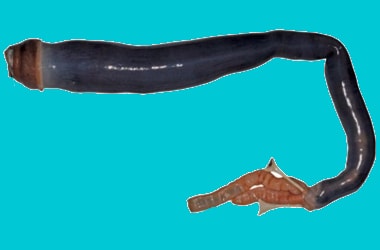 Scientists have discovered the first live specimen of a bizarre, giant worm-like animal in the Philippines. Scientists have discovered the first live specimen of a bizarre, giant worm-like animal in the Philippines.
This worm plants itself into mud like carrots and feeds on noxious fumes of sulphur.
The existence of the black, mud dwelling creature has been known for centuries.
Its tusk-like shells, measuring three to five feet long, were first documented in the 18th century.
"The shells are fairly common. But we have never had access to the animal living inside.
Scientists set up an expedition and found live specimens of Kuphus polythalamia planted like carrots in the mud of a shallow lagoon.
With a live giant shipworm finally in hand, researchers carefully washed the sticky mud caked to the outside of the giant shipworm shell and tapped off the outer cap, revealing the creature living inside.
The giant shipworm was radically different from other wood-eating shipworms.
The worm was found in a remote habitat–a lagoon laden with rotting wood.
Normal shipworm burrows deep into the wood of trees that have washed into the ocean, munching on and digesting the wood with the help of bacteria.
Unlike its shipworm cousins, Kuphus lives in the mud. It also turns to bacteria to obtain nourishment, but in a different way.
Kuphus lives in a pretty stinky place. The organic-rich mud around its habitat emits hydrogen sulfide, a gas derived from sulphur, which has a distinct rotten egg odour.
This environment may be noxious for you and me, but it is a feast for the giant shipworm, researchers said.
Kuphus themselves do not eat, or if they do, they eat very little.
Instead, they rely on beneficial bacteria that live in their gills that make food for them.
Like tiny chefs, these bacteria use the hydrogen sulfide as energy to produce organic carbon that feeds the shipworm.
This process is similar to the way green plants use the Sun's energy to convert carbon dioxide in the air into simple carbon compounds during photosynthesis.
As a result, many of Kuphus's internal digestive organs have shrunk from lack of use.
|
▼ Now, scientists develop wristband that uses sweat for diagnosis [04-19-17]
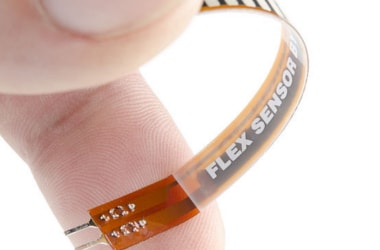 Stanford scientists have developed a new wristband-type wearable device that can analyse sweat to diagnose and monitor diseases like diabetes and cystic fibrosis. Stanford scientists have developed a new wristband-type wearable device that can analyse sweat to diagnose and monitor diseases like diabetes and cystic fibrosis.
The new sensor collects sweat, measures its molecular constituents, such as chloride ions and glucose and then transmits the results for analysis and diagnostics.
Unlike old-fashioned sweat collectors, the new device does not require patients to sit still for a long time while sweat accumulates in the collectors.
The two-part system of flexible sensors and microprocessors sticks to the skin, stimulates the sweat glands and then detects the presence of different molecules and ions based on their electrical signals.
The more chloride in the sweat, for example, the more electrical voltage is generated at the sensor's surface.
The team at Stanford University in the US used the wearable sweat sensor in separate studies to detect chloride ion levels–high levels are an indicator of cystic fibrosis–and to compare levels of glucose in sweat to that in blood.
High blood glucose levels can indicate diabetes.
This wearable can track your ECG.
Conventional methods for diagnosing cystic fibrosis require that patients visit a specialised centre and sit still while electrodes stimulate sweat glands in their skin to provide sweat for the test.
Children have to sit still for 30 minutes while an instrument attached to their skin collects sweat.
By comparison, the wearable sweat sensor stimulates the skin to produce minute amounts of sweat, quickly evaluates the contents and beams the data by way of a cellphone to a server that can analyse the results.
People living in remote villages in developing countries, where conventional testing is unavailable, could also benefit from a portable, self-contained sweat sensor, he said.
The wearable device is robust and can be run with a smartphone, which can send measurements to a cloud and receive a result right back after review at a specialised centre.
Researchers also measured glucose levels in sweat, which correspond to blood glucose levels, making the device potentially useful for monitoring pre-diabetes and diabetes.
Researchers develop flexible wearable device to monitor body signals
However, the technology can also be used to measure other molecular constituents of sweat, such as sodium and potassium ions and lactate.
The platform can be used to measure virtually anything found in sweat.
Sweat is hugely amenable to wearable applications and a rich source of information.
A wearable sweat sensor allows for frequent monitoring to see how patients respond to a treatment or if they are complying with treatment.
|
▼ Glacier thinning determined by shape [04-19-17]
 A glacier's risk of thinning can be predicted by analysing its shape. A glacier's risk of thinning can be predicted by analysing its shape.
Researchers at The University of Texas at Austin in the US identified glaciers in West Greenland that are most susceptible to thinning in the coming decades by analysing how they are shaped.
The Greenland Ice Sheet is the second-largest ice sheet on Earth and has been losing mass for decades, a trend scientists have linked to a warming climate.
However, the mass change experienced by individual coastal glaciers, which flow out from the ice sheet into the ocean, is highly variable.
This makes predicting the impact on future sea-level rise difficult.
The new study could help predict how much the Greenland Ice Sheet will contribute to future sea-level rise during the next century.
This is a number that currently ranges from inches to feet.
The analysis works by calculating how far inland thinning that starts at the terminus of each glacier is likely to extend.
Glaciers with thinning that reaches far inland are the most susceptible to ice mass loss.
How susceptible a glacier is to thinning depends on its thickness and surface slope, features that are influenced by the landscape under the glacier.
Thinning spreads more easily across thick and flat glaciers and is hindered by thin and steep portions of glaciers, researchers said.
These calculations will help improve estimates on how much Greenland can contribute to future sea- level rise. However, while the method can point out vulnerable areas, it can not predict how much mass loss is likely to occur.
|
▼ Harisal village: Microsoft's first ideal digital village in India [04-18-17]
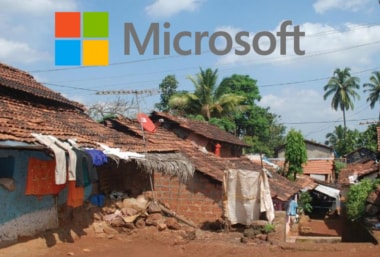 Harisal village was adopted by Microsoft to be developed as India’s first ideal digital village. Harisal village was adopted by Microsoft to be developed as India’s first ideal digital village.
Underpinned by public health initiatives of the state government, the village is now in the reckoning for the Prime Minister’s Award for excellence in Public Administration.
It may provide a replicable public-service delivery model for the whole state.
Two key initiatives began for the first ideal digital village turning the wheel,
Creating an approach of just increasing access to fair-price shops was not going to solve the problem.
In villages like Harisal, this never helped curb malnutrition.
Second, the government sought a comprehensive view of the population in the region to find a solution to the seemingly endemic health problem.
Villages like Harisal score significantly low in all the Human Development Index parameters, such as education, employment, and income levels.
The government’s next big initiative was, therefore, built around the granularity of data.
Both have benefited Harisal
Harisal: Know More
- Taluka Name : Dharni
- District : Amravati
- State: Maharashtra
- Region: Vidarbha
- Division: Amravati
- Language: English and Hindi, Marathi,
- Elevation / Altitude: 304 meters. Above Seal level
- Assembly constituency: Melghat assembly constituency
- Assembly MLA: Bhilawekar Prabhdas Babulal(2017)
- Lok Sabha constituency: Amravati parliamentary constituency
- Parliament MP: Adsul Anandrao Vithoba(2017)
|
▼ Now, a 3D patch for a broken heart! [04-18-17]
 The discovery is a major step forward in treating patients with tissue damage after a heart attack. The discovery is a major step forward in treating patients with tissue damage after a heart attack.
During a heart attack, a person loses blood flow to the heart muscle and that causes cells to die.
Our bodies can not replace those heart muscle cells so the body forms scar tissue in that area of the heart, which puts the person at risk for compromised heart function and future heart failure.
Researchers used laser-based 3D-bioprinting techniques to incorporate stem cells derived from adult human heart cells on a matrix that began to grow and beat synchronously in a dish in the lab.
When the cell patch was placed on a mouse following a simulated heart attack, the researchers saw significant increase in functional capacity after just four weeks.
Since the patch was made from cells and structural proteins native to the heart, it became part of the heart and absorbed into the body, requiring no further surgeries.
The research is different from previous ones as the patch is modelled after a digital, three- dimensional scan of the structural proteins of native heart tissue.
The digital model is made into a physical structure by 3D printing with proteins native to the heart and further integrating cardiac cell types derived from stem cells.
Only with 3D printing of this type can researchers achieve one micron resolution needed to mimic structures of native heart tissue.
|
▼ Map The Future conference in New Delhi [04-18-17]
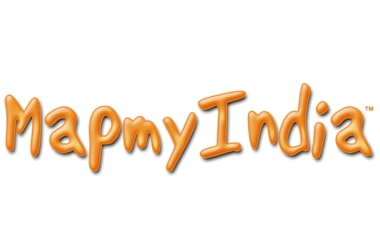 During this conference, MapMyIndia, a domestic mapping and navigation services provider announced it will be creating the Digital Twin of the Real World. During this conference, MapMyIndia, a domestic mapping and navigation services provider announced it will be creating the Digital Twin of the Real World.
This Real View Digital Map Twin will capture, recognize and publish real-as-life 3D and 360-degree maps of both outdoors and indoors through GPS, laser and panoramic camera sensors, embedded on top of ground-based vehicles, back-packs, trains, flying drones, and trolleys that can move quickly indoors.
MapmyIndia's Real View platform can be updated continuously using the company's IoT (Internet of Things) platform, called InTouch.
It's claimed to be capable of processing enormous streams of real-time video and data from vehicle sensors and other crowd reports based on traffic and road conditions.
The company will also be using the eLoc Digital Address System to simplify the identification and communication of every address, place and object in the real world.
To further its efforts in this direction, MapmyIndia announced that it has acquired Bengaluru-based VIDTEQ, renowned for its video mapping solutions.
VIDTEQ is claimed to have video mapped more than 20 cities in India.
The company uses its VideoMap technology to address location and direction information for builders, schools, colleges, resorts and other businesses.
|
▼ IISc scientists develop potent molecules for fighting TB [04-18-17]
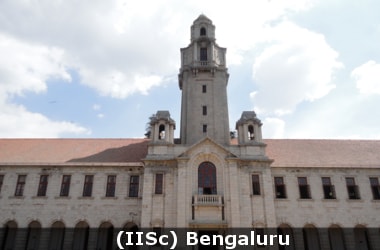 Scientists at the Indian Institute of Science (IISc) Bengaluru have developed two new, potent molecules that can severely impact the survival of mycobacteria. Scientists at the Indian Institute of Science (IISc) Bengaluru have developed two new, potent molecules that can severely impact the survival of mycobacteria.
This is including Mycobacterium tuberculosis that causes TB.
Unlike most antibiotics that target the bacterial metabolism by aiming at the cellular components, the novel molecules inhibit the stress response pathway of mycobacteria.
The stress response pathway is crucial for bacteria to survive during hostile conditions such as lack of nutrients and the presence of antibiotics, to name a few.
So any inhibition of this pathway will lead to its death.
The master regulator of stress pathway in the case of mycobacteria is (p)ppGpp (Guanosine pentaphospahte or Guanosine tetraphosphate).
Though a molecule that inhibits the (p)ppGpp formation has already been synthesised, the efficacy is not much.
Very high concentration of Relacin molecule is needed to inhibit the pathway and, therefore, the efficacy is low.
So scientists synthesised two new molecules - acetylated compound (AC compound) and acetylated benzoylated compound (AB compound) - by bringing about a modification in the base of the Relacin molecule.
The two compounds affected the rate of synthesis of (p)ppGpp and also reduced the cell survival.” Additionally, the two molecules were not toxic to human cells and were able to penetrate the human lung epithelial cells.
“The Alarmone molecule “(p)ppgpp”, a modified nucleotide, is ubiquitous in bacteria and absent in humans.
Inhibiting (p)ppgpp synthesis would specifically target the survival of bacteria without having any effects on humans.
Earlier studies have shown that when the rel gene is deleted, the long-term survival ability under stress was lost.
Under hostile conditions, bacteria tend to form biofilms, which protect the bacteria from stress and induce tolerance to antibiotics.
Recent studies have shown that tuberculosis bacteria that cannot form a biofilm cannot survive inside the host. Evidences have shown that at the time of infection, the M. tuberculosis display a biofilm-like phenotype and this helps the bacteria to survive inside the host.
Both M. tuberculosis and M. smegmatis that do have the Rel gene cannot form a biofilm.
Studies carried out by the researchers showed that both the molecules were able to inhibit biofilm formation by M. tuberculosis and M. smegmatis and also disrupt the already formed biofilm.
|
▼ Meet Moabosaurus utahensis, a herbivore dinosaur [04-18-17]
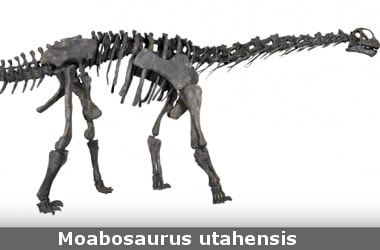 Scientists have discovered a new species of a herbivorous dinosaur that lived about 125 million years ago. Scientists have discovered a new species of a herbivorous dinosaur that lived about 125 million years ago.
The new species belongs to a group of herbivores known as sauropods, which includes giants such as Brontosaurus and Brachiosaurus, who had long necks and pillar-like legs.
This is according to researchers from the Brigham Young University (BYU) in the U.S.
The bones of the dinosaur called Moabosaurus utahensis were assembled using bones extracted over the course of four decades.
Moabosaurus is most closely related to species found in Spain and Tanzania, which tells researchers that during its time, there were still intermittent physical connections between Europe, Africa and North America.
Moabosaurus lived in Utah at a time when the region was filled with large trees, plentiful streams, lakes and dinosaurs, researchers said.
A previous study indicates that a large number of Moabosaurus and other dinosaurs died in a severe drought.
Survivors trampled their fallen companions’ bodies, crushing their bones.
|
▼ NIO launched robotic platform SERP [04-17-17]
Scientists at CSIR-National Institute of Oceanography (NIO) have developed a robotic platform, Seabed Resident Event Profiler (SREP).
This is a platform that is capable of being stationed at any water depth from 0-200 metres to track the oceanic processes.
The robot has been designed to regularly record the water column information at every 10 to 25 cm during every profile four times a day.
The robot was tested during the recent voyage of RV Sindhu Sadhana, the latest state of the art research vessel of NIO.
The SREP robot has been designed particularly to carry out studies related to the monsoon, global climate and upwelling.
Upwelling is a phenomenon associated with the monsoon that sees the migration of deep sea oxygen minimum zone (OMZ) towards the coast.
It also brings the nutrient-rich water to the surface and enhances the biological productivity of the region.
Several sensors attached to SREP is capable of detecting the conditions associated with upwelling such as low temperature, low oxygen, high nutrients, and changes in density patterns etc.
This enables SREP to effectively track upwelling during June to September.
Upwelling is an important phenomenon for the ecosystem sustenance and fishery. Similarly, since south-west monsoon forms the backbone of the country’s economy, knowing the conditions for its onset forms one of the major goals of Seabed Resident Event Profiler.
The robot in its final configuration will be capable of sitting on the seabed for 100 days continuously to track the oceanic processes in the upcoming monsoon season.
CSIR-NIO: Know More - CSIR-NIO CSIR-NIO was established on 1 January 1966.
- Its headquarters are at Dona Paula, Goa.
- It has regional centres at Kochi, Mumbai and Visakhapatnam.
- CSIR-NIO was established following the International Indian Ocean Expedition (IIOE) in the 1960s. CSIR-NIO primarily focuses on research over traditional branches of oceanography such as biological, chemical, geological/geophysical.
- It also involves physical as well as over ocean engineering, marine instrumentation and marine archaeology.
|
▼ IRDAI launches web portal for insurers, intermediaries [04-17-17]
The Insurance Regulatory and Development Authority of India (IRDAI) has launched a web portal for insurers that will allow them to register and sell policies online.
The portal - isnp.irda.gov.in - is also open to intermediaries in insurance business.
IRDAI had issued guidelines on e-commerce for insurance sector.
IRDAI indicated insurance companies, brokers and corporate agents can sell and service insurance policies through this platform.
Insurers and intermediaries can create a login credential for registration and submit ISNP application form on the portal.
In its guidelines issued in March, IRDAI allowed that companies may offer discounts to customers if their policies are sold through e-commerce websites.
|
▼ IT issues PAN within a day, launches e-PAN [04-12-17]
 The IT department has issued Permanent Account Number (PAN) within a day to 19,704 newly incorporated companies till March 31, 2017. The IT department has issued Permanent Account Number (PAN) within a day to 19,704 newly incorporated companies till March 31, 2017.
In addition to physical PAN card, CBDT has introduced the Electronic PAN (e-PAN) card, which is sent by email to all applicants, including individuals.
Applicant would be benefited by having a digitally signed E-PAN card which they can submit as proof of identity to other agency electronically directly or by storing in the Digital Locker (https://digilocker.gov.in).
The PAN issue was mandated by CBDT, the apex policy making body of the Income Tax department.
The newly incorporated companies have also been issued Tax Deduction Account Number (TAN) simultaneously with PAN as the Central Board of Direct Taxes (CBDT) has tied up with the Ministry of Corporate Affairs (MCA) under which companies can submit a common application form.
Applicant companies submit a common application form SPICe (INC 32) on MCA portal and once the data of incorporation is sent to CBDT by the MCA, PAN and TAN are issued immediately without any further intervention of the applicant.
The Certificate of Incorporation (COI) of newly incorporated companies includes the PAN in addition to the Corporate Identity Number (CIN).
TAN is also allotted simultaneously and communicated to the company.
Till March 31, 2017, 19,704 newly incorporated companies were allotted PAN in this manner.
During March 2017, of the 10,894 newly incorporated companies, PAN was allotted within 4 hours in 95.63 per cent cases and within one day in all cases.
Similarly, TAN was allotted to all such companies within 4 hrs in 94.7 per cent cases and within 1 day in 99.73 per cent cases.
Income Tax Department: Know More
- Formed: 1922
- Jurisdiction: Government of India
- Employees: 46,000 (2016-17 est.)
- Minister responsible: Arun Jaitley, Finance Minister
- Key executive : Sushil Chandra IRS ( IT: 1980), Chairman, Central Board of Direct Taxes
- Parent department: Department of Revenue
- Website : incometaxindia.gov.in
|
▼ Now, hear Stonehenge's prehistoric sounds [04-12-17]
 Scientists have developed an app to tap the prehistoric acoustics that swirled around Britain's ancient monument Stonehenge over the last 5,000 years. Scientists have developed an app to tap the prehistoric acoustics that swirled around Britain's ancient monument Stonehenge over the last 5,000 years.
A team of researchers spent eight years creating an app that allows you to hear the different noises the stones generated at various points over thousands of years.
While most modern archaeologists generally agree Stonehenge was some sort of prehistoric temple aligned to the movements of the sun, the researchers found the stones also had surprisingly sonorous properties.
This is one of the few human-made places where you’d have heard these kind of acoustic effects."
The app allows listeners to wander amongst the standing stones while listening to an interactive soundscape–including the sound of birds and the wind moving through the stones.
Stonehenge: Know More
- Address: Amesbury, Salisbury SP4 7DE, UK
- Construction started: 3100 BC
- Designated: 1986 (10th session)
- Region: Europe and North America
|
▼ Jupiter has second "Great Spot" [04-12-17]
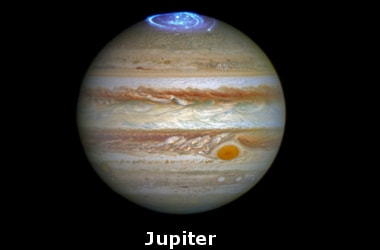 Scientists reported 11th April 2017 that the dark expanse of the second Great Spot is 15,000 miles (24,000 kilometres) across and 7,500 miles (12,000 kilometres) wide. Scientists reported 11th April 2017 that the dark expanse of the second Great Spot is 15,000 miles (24,000 kilometres) across and 7,500 miles (12,000 kilometres) wide.
It’s in the upper atmosphere and much cooler than the hot surroundings, thus the name Great Cold Spot.
Unlike giant planet’s familiar Great Red Spot, this newly discovered weather system is continually changing in shape and size.
It’s formed by the energy from Jupiter’s polar auroras.
Scientists were charting the temperature and density of Jupiter’s atmosphere.
When the researchers compared the data with thousands of images taken in years past by a telescope in Hawaii, the Great Cold Spot stood out.
It could be thousands of years old.
The Great Cold Spot is much more volatile than the slowly changing Great Red Spot.
Jupiter: Know More
- Radius: 69,911 km
- Mass: 1.898 × 10^27 kg (317.8 M⊕)
- Surface pressure: 20–200 kPa (cloud layer)
- Equatorial rotation velocity: 12.6 km/s; 45300 km/h
- Polar radius: : 66,854±10 km; 10.517 Earths;
- Important Moons: Europa, Ganymede, Io, Callisto, Adrastea, Amalthea, Thebe
|
▼ Now, monitor fever visually! [04-12-17]
 Visual, non-invasive monitoring of body temperature of patients without using a thermometer may become a reality soon, thanks to the work carried out by a team of scientists at Indira Gandhi Centre for Atomic Research (IGCAR), Kalpakkam, near Chennai. Visual, non-invasive monitoring of body temperature of patients without using a thermometer may become a reality soon, thanks to the work carried out by a team of scientists at Indira Gandhi Centre for Atomic Research (IGCAR), Kalpakkam, near Chennai.
The concept is based on ferrofluid emulsion contained in a thin film that changes colour with rise in temperature within a narrow range - 30-40° C.
The emulsion has iron oxide nanoparticles containing oil droplets dispersed in water.
Till now ferrofluid was used as a magnetic stimuli-responsive material.
Scientists now found that in the presence of a temperature-sensitive polymer - poly(N-isopropylacrylamide), also known as PNIPAM) - the ferrofluid emulsion can be used as a thermally tunable grating to produce different colours.
The adsorbed polymer swells and collapses upon changing the temperature between 32° and 36° C.
This change was clearly manifested as colour change.
From this observation came the novel idea of using PNIPAM-stabilised emulsions as a multistimulii grating.
This is a first of its kind approach where the grating spacing can be tuned either by changing the temperature or by changing the magnetic field strength.
Up to about 34° C, the polymer is highly hydrated and swollen due to repulsive interaction between individual monomer segments.
But when the temperature crosses 34° C, the polymer becomes dehydrated leading to a collapsed state.
The polymer will once again become hydrated and swollen when the temperature falls below 34° C.
Scientists can use additives to tune the collapse of the polymer to higher temperature to reflect fever condition.
Using magnetic fields, the scientists first achieved a particular ordering (spacing between the arrays of emulsion droplets) of emulsion and got a particular colour.
When polymer is added as a stabiliser and the temperature is increased, the grating spacing of the polymer changes and gives rise to a different colour or spacing.
“The colour given off at normal temperature can be fixed by changing the emulsion property and magnetic field strength,” Dr. Philip says.
If the normal temperature is fixed at yellow, the change will be to green when the temperature increases.
Colour with higher wavelength is produced at lower temperature and colour of lower wavelength at higher temperature.
|
▼ Now, access 3000 SGI maps using Aadhaar [04-11-17]
 The government launched a dedicated website allowing the public the access to download 3,000 maps prepared by the Survey General of India (SGI) but made Aadhaar mandatory for the purpose. The government launched a dedicated website allowing the public the access to download 3,000 maps prepared by the Survey General of India (SGI) but made Aadhaar mandatory for the purpose.
Using Aadhaar number, a person can download three maps every day from the portal (http://soinakshe.uk.gov.in/).
The SGI completes 250 years on April 10, 2017 marking this initiative.
Motto behind making Aadhaar mandatory for using this service was to make it available "only to Indians".
Aadhaar number is a proof of identity and not that of citizenship.
The initiative comes days after Aadhaar was made mandatory for filing Income Tax Returns.
The government is also mulling to make Aadhaar mandatory for booking air tickets.
Government may use alternative solution for backing local manufacturing under GST
SGI: Know More
- The SGI has the mandate of making maps and cartographic documents for the country.
- It has a wide archive of maps.
- The institute first published a 'Map of Hindoostan' in 1783, depicting the subcontinent region comprising India, Pakistan, Burma (now Myanmar), Bangladesh, and parts of Afghanistan.
- The SGI has a rich collection of over 5,000 maps. While it made 3,000 maps open to public for download, 1700 will be available for downloading soon
- Under the National Map Policy 2005, it had become necessary to make non-defence maps accessible for public.
|
▼ Bharat Ke Veer: MHA launches donor app, site for soldiers [04-10-17]
 Union Home Minister Shri Rajnath Singh launched the web portal and mobile application named “Bharat ke Veer”. Union Home Minister Shri Rajnath Singh launched the web portal and mobile application named “Bharat ke Veer”.
The portal is an IT based platform, with an objective to enable willing donors to contribute towards the family of a braveheart who sacrificed his/her life in line of duty.
The Minister of State for Home Affairs Shri Kiren Rijiju and actor Akshay Kumar also participated.
The site “Bharat ke Veer” will be available on web portal as well as mobile application.
The amount so donated will be credited to the account of ‘Next of Kin’ of those Central Armed Police Force/Central Para Military Force soldiers.
This domain allows anyone to financially support the bravehearts of his/her choice or towards the “Bharat Ke Veer” corpus.
This website is technically supported by National Informatics Centre (NIC) and powered by SBI.
To ensure maximum coverage, a cap of 15 lakh rupees is imposed and the donors would be alerted if the amount exceeds, so that they can choose to divert part of the donation to another braveheart account or to the “Bharat Ke Veer” corpus.
“Bharat Ke Veer” corpus would be managed by a committee made up of eminent persons of repute and senior Government officials, who would decide to disburse the fund equitably to the braveheart’s family on need basis.
|
▼ Now, self healing screens for smartphones [04-10-17]
 Phones with cracked screens is a common sight these days and scientists at University of California have come up with a method to solve this problem. Phones with cracked screens is a common sight these days and scientists at University of California have come up with a method to solve this problem.
They have successfully created a self-healing material which when carved into two parts, can go back together like nothing has happened.
The material is a made up of stretchable polymer and an ionic salt.
It can stretch up to 50 times its original size also capable of conducting electricity.
All these features combined make it a viable material for producing smartphones screen.
The substance has potential applications in the field of soft robotics as well.
The polymer is based on the premise that materials consist of a mix of strong covalent bonds and weaker non-covalent bonds.
When a material gets damaged, non-covalent bonds protect covalent bonds by getting broken first.
As weak as these non-covalent bonds are, however, they’re also reversible, which means after they’re broken, they can also recover. And this cycle can be repeated over and over again.
The properties are attributed to a specific kind of bond called ion dipole interaction, basically force between ions and molecules.
What happens is that when the two ends of the broken material meet, this force causes the ions and molecules to get attracted to each other.
The ion-dipole interaction causes the broken non-covalent bonds to reunite and reform, resulting in the material healing its own damage.
The research team's inspiration for self-healing material was comes from Marvel superhero Wolverine!
|
▼ IISc researchers discover unique electrical conductor [04-10-17]
Researchers from the Indian Institute of Science (IISc), Bengaluru have been able to experimentally produce a new type of electrical conductor that was theoretically predicted nearly 20 years ago.
The team produced graphene that is single- or a few-layers thick to conduct current along one particular edge — the zigzag edge.
The zigzag edge of graphene layer has a unique property: It allows flow of charge without any resistance at room temperature and above.
This is the first time one has found the perfect edge structure in graphene and demonstrated electrical conductance along the edge.
A few-layers-thick graphene that conducts current along one edge does not experience any resistance and so can lead to realising power-efficient electronics and quantum information transfer, even at room temperature.
Many groups over the world have been trying to access these edges since the emergence of graphene in 2004, but have been largely unsuccessful because when current flows through graphene, it flows through both the edge as well as the bulk.
By creating the bulk part of graphene extremely narrow (less than 10 nanometre thick), and hence highly resistive, thus forcing the current to flow through the edge alone, IISc scientists have overcome this block.
While the bulk is totally insulating, the edge alone has the ability to conduct because of the unique quantum mechanics of the edge.
As the zigzag orientation of carbon atoms [resulting from the hexagonal lattice], the electron wave on each carbon atom overlaps and forms a continuous train of wave along the edge.
This makes the edge conducting, even if it is very long but has to be chemically and structurally pristine.
In the past, others researchers had tried making narrow graphene through chemical methods.
But the use of chemicals destroys the edges. So the IISc team resorted to mechanical exfoliation to make graphene that are single- and few-layers thick.
There are currently several chemical methods to produce very narrow graphene nanoribbons. But these chemicals tend to destroy the edges.
So the challenge is to produce graphene nanoribbons using chemicals that do not destroy the edges.
This innovation makes high-quality graphene nano-ribbons or nano-strips with clean edges possible.
|
▼ ISRO to innovate private sector with new battery [04-10-17]
The government has asked Indian Space Research Organisation (ISRO) to allow manufacturers interested in producing indigenous lithium-ion batteries.
This is including those from private sector, to obtain the technology for its mass production.
ISRO will now come up with a framework to make this process smooth.
The Vikram Sarabhai Space Centre under ISRO has developed indigenous technology to manufacture such high-power batteries for automobiles and e-vehicles and their feasibility tests in vehicles have been successful.
Over half a dozen major automobile companies, battery manufacturers and public sector undertakings have already approached ISRO.
This include Mahindra Renault, Hyundai, Nissan, Tata Motors, High Energy Batteries, BHEL and Indian Oil.
The aim is to develop indigenous technology for lithium-ion batteries so that their prices are within the reach of Indian customers.
ISRO had earlier developed similar batteries for satellite and the launch vehicle applications.
The government has set an ambitious target for pushing more use of electric vehicles to reduce air pollution, which has become one of the biggest health concerns.
Batteries are the key component of any electric vehicle.
At present, all lithium-ion batteries are imported and it's very expensive.
Such batteries have high-power, but these weigh less and their volume is much less as well in comparison to conventional batteries.
Government documents show the cost of lithium-ion batteries is high because of small volume of procurement.
Bulk procurement and mass production can reduce the cost by 80%, which is key to push demand.
Lithium Ion Batteries: Know More - Specific energy: 100–265 W·h/kg (0.36–0.875 MJ/kg)
- Energy density: 250–676 W·h/L (0.90–2.43 MJ/L)
- Specific power: ~250-~340 W/kg
- Charge/discharge efficiency: 80–90%
- Self-discharge rate per month: 8% at 21 °C/15% at 40 °C/31% at 60 °C
- Cycle durability:400–1200 cycles
- Nominal cell voltage: NMC 3.6 / 3.85 V, LiFePO4 3.2 V
- A lithium-ion battery or Li-ion battery (abbreviated as LIB) is a type of rechargeable battery.
|
▼ Now a graphene sieve for removing salt from sea! [04-7-17]
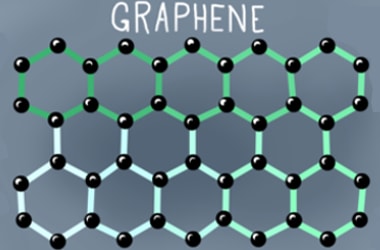 Researchers have developed a graphene-based sieve capable of removing salt from seawater, an advance that may provide clean drinking water for millions of people. Researchers have developed a graphene-based sieve capable of removing salt from seawater, an advance that may provide clean drinking water for millions of people.
When immersed in water, graphene-oxide membranes become slightly swollen and smaller salts flow through the membrane along with water, while larger ions or molecules are blocked.
Researchers have now successfully developed graphene membranes and found a strategy to avoid the swelling of the membrane when exposed to water.
The pore size in the membrane can be precisely controlled, which can sieve common salts out of salty water and make it safe to drink.
When the common salts are dissolved in water, they always form a ‘shell’ of water molecules around the salt molecules.
This allows the tiny capillaries of the graphene-oxide membranes to block the salt from flowing along with the water.
Water molecules are able to pass through the membrane barrier and flow anomalously fast which is ideal for application of these membranes for desalination, researchers said.
Realisation of scalable membranes with uniform pore size down to atomic scale is a significant step forward and will open new possibilities for improving the efficiency of desalination technology according to Professor Rahul Nair, University of Manchester.
The membranes are not only useful for desalination, but the atomic scale tunability of the pore size also opens new opportunity to fabricate membranes with on-demand filtration capable of filtering out ions according to their sizes.
|
▼ MHA launches website for NPDDR meeting [04-7-17]
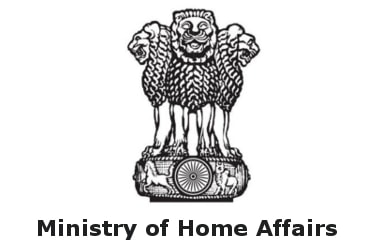 The Union Minister of State for Home Affairs, Shri Hansraj Gangaram Ahir launched the website, http://npdrr2-mha.net.in, for the ensuing 2nd meeting of National Platform on Disaster Risk Reduction (NPDRR). The Union Minister of State for Home Affairs, Shri Hansraj Gangaram Ahir launched the website, http://npdrr2-mha.net.in, for the ensuing 2nd meeting of National Platform on Disaster Risk Reduction (NPDRR).
This is an exclusive website to share all information related to the NPDRR and keep updating delegates on daily basis about the meeting.
The 2nd meeting of the NPDRR will be held in the last week of April this year in New Delhi on the theme 'Disaster Risk Reduction for Sustainable Development: Making India Resilient by 2030'.
The first meeting of NPDRR was held during May 13 -14, 2013 in New Delhi on the theme 'Mainstreaming DRR in Development: From Risk to Resilience'.
The NPDRR is a multi-stakeholder National Platform headed by the Union Home Minister.
It consists of representatives from Central Government, State Governments, Local Self Governments, Parliament, Specialised agencies dealing with disaster, Institutions of National Importance, Industry, Media, Civil Society Organizations and International Organizations.
The NPDRR promotes participatory decision making in disaster management and strengthens federal policy of our country.
National Disaster Management Authority (NDMA) and National Institute of Disaster Management (NIDM) are organizing 10 pre-events on different aspect of DRR in collaboration with their partner organizations as a build up to this 2nd meeting of NPDRR.
A national level slogan competition on "Role of NPDRR in disaster management" has been launched on March 31, 2017 to enhance citizen's involvement in Disaster Management.
|
▼ GARV app upgraded [04-7-17]
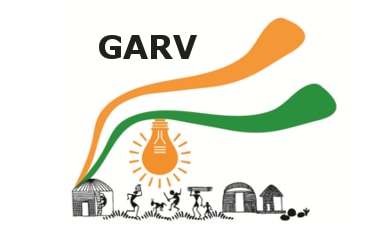 Grameen Vidyutikaran (GARV) App has been upgraded for monitoring the villages and households electrification in the country. Grameen Vidyutikaran (GARV) App has been upgraded for monitoring the villages and households electrification in the country.
GARV-II includes monitoring of electrification of habitations as well as households. It also provides an interactive platform for feedback and would help in expediting electrification works.
Government of India has launched Deendayal Upadhyaya Gram Jyoti Yojana (DDUGJY) with total investment of Rs.43,033 crore in the country in December, 2014 with the objectives of, inter-alia,
(i) Village Electrification;
(ii) Providing access to households;
(iii) Feeder Separation;
(iv) Strengthening of sub-transmission and distribution network and
(v) Metering.
Under DDUGJY, projects of an amount of INR.42553.17 crore have been sanctioned for rural electrification works which include village electrification, access to households, feeder separation, metering and system strengthening.
Initiatives to Improve Efficiency of Coal Plants: Know More
- The Government has taken several steps to modernize and improve the efficiency of coal based thermal power plants and to reduce the pollution level of coal based thermal power plants in the vicinity of these plants.
- Supercritical technology has already been adopted for thermal power generation.
- The design efficiency of Supercritical units is about 5% higher than that of typical 500 MW subcritical units and these (supercritical) units are likely to have correspondingly lower fuel consumption and CO2 emissions in ambient air.
- A capacity addition of 39,710 MW power based on supercritical technology has already been achieved and 48,060 MW of supercritical technology is in the pipeline.
- All Ultra Mega Power Projects (UMPPs) are required to use supercritical technology.
- Coal based capacity addition during the 13th Plan period shall be through super-critical units.
- Indigenous research is being pursued for development of an Advanced Ultra Supercritical Technology (A-USC) with targeted efficiency improvement of about 10% over supercritical unit.
- Indira Gandhi Centre for Atomic Research (IGCAR), NTPC Ltd. and BHEL signed an MoU, in August 2010, for development of 800 MW A-USC indigenous demonstration plant with main steam pressure of 310 kg/cm2 and temperature of 710/ 720 deg C.
- A capacity of about 7751.94 MW of old and inefficient unit has already been retired till date.
- To facilitate State Utilities/IPPs to replace old inefficient coal based thermal units with supercritical units, Ministry of Coal, Government of India has formulated a policy of automatic transfer of Letter of Assurance (LOA)/Coal linkage (granted to old plants) to new (proposed) super-critical units.
- Perform Achieve and Trade (PAT) Scheme under National Mission on Enhanced Energy Efficiency is under implementation by BEE (Bureau of Energy Efficiency). In PAT cycle–II, individual target for improving efficiency has been assigned to 154 thermal power stations.
High efficiency Electrostatics Preceptor (ESP) are installed to capture Particulate Matters from Flue gases. - Low NOX burners are installed for reducing NOx emission from flue gases.
- SO2 emission control is achieved through dispersion of flue gases through tall stacks (275 metres) to reduce the concentration of polluting gases at ground level.
|
▼ BARC develops anti cancer medicine [04-5-17]
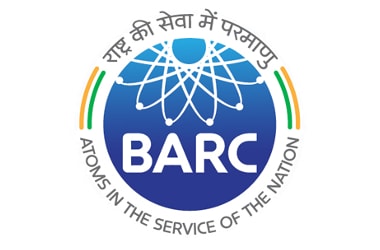 BARC scientists have developed two anti-cancer medicines from the fruit extract of the Rampatri plant, which may help destroy tumours and revive cells damaged by radiation. BARC scientists have developed two anti-cancer medicines from the fruit extract of the Rampatri plant, which may help destroy tumours and revive cells damaged by radiation.
Rampatri plant, which is used as a spice in foods, belongs to the Myristicaceae family and is found in western coastal region of the country.
Scientists at Bhabha atomic Research Centre (BARC) based in Anushaktinagar, Mumbai tested the medicines made from this plant on mice and found that they may help in treating lung cancer and neuroblastoma, a rare cancer found in children.
In neuroblastoma, cancer cells grow in nerve cells of adrenal glands, neck, chest and spinal chord.
The medicines were developed by Dr B Shankar Patro, scientist of Radiation Biology and Health sciences at BARC.
The molecules of Rampatri fruit may destroy the cancer cells.
Medicines developed from these molecules may also help in reviving cells destroyed due to radiation.
The research centre was working for many years to develop cancer medicines from herbal plants.
They have also developed BARC Radio Modifier and BARC Radio Protector.
From June this year, Tata Memorial Centre in Mumbai may begin clinical trial of Radio Modifier medicine.
Radio Modifier helps to protect healthy cells during radiation therapy and if this medicine is given within four hours in case of any nuclear accident, life of the affected person may be saved.
BARC: Know More
- Director: K.N. Vyas
- Location: India
- Headquarters: Mumbai
- Founder: Homi J. Bhabha
- Founded: 3 January 1954
- Budget: 31.59 billion INR (US$470 million, 2015–2016)
- Purpose: Nuclear physics
|
▼ Planet found orbiting x-ray binary for first time [04-4-17]
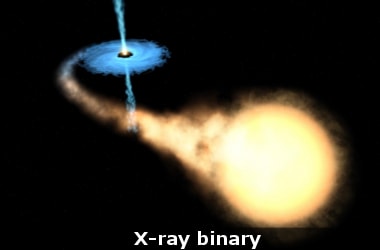 A team of scientists from Raman Research Institute, Bengaluru and University of Delhi for the first time have seen indications of a massive planet orbiting a low mass X-ray binary star system. A team of scientists from Raman Research Institute, Bengaluru and University of Delhi for the first time have seen indications of a massive planet orbiting a low mass X-ray binary star system.
The system MXB 1658-298 is an X-ray binary and a part of the constellation Ophiuchus (serpent bearer).
It is nearly 30 thousand light years away and the planet is expected to be nearly 8 thousand times as massive as the earth.
X-ray binaries consist of a pair of stars orbiting each other of which one is compact such as a black hole or a neutron star.
In this case it is a neutron star which draws matter from its less-massive companion and generates X-rays which are detected by detectors placed in satellites in space.
This discovery is made with a new technique, X-Ray observation by measuring periodic delays in X-ray eclipses.
It is a new technique of detecting exoplanets and observations are done from space observatories.
In X-ray binaries, the time in-between eclipses of the source can increase, decrease and also shows abrupt changes.
But in MXB 1658-298, time between the eclipses increases and decreases periodically.
|
▼ Germany's armed forces launch cyber command [04-3-17]
Germany's armed forces on April 1, 2017 launch a cyber command, with a status equal to that of the army, navy and air force, meant to shield its IT and weapons systems from attack.
Military planners fear that wars of the future will start with cyber attacks against critical infrastructure and networks, extensive online espionage and sabotage.
The Bundeswehr's new Cyber and Information Space (CIR) Command, based in the former West German capital of Bonn, will start off with 260 IT specialists.
It will grow to 13,500 military and civilian personnel by July.
With the new digital force, Germany is taking a leading role among NATO allies, its new commander, Lieutenant General Ludwig Leinhos, announced.
The main tasks would be to operate and protect the military's own IT infrastructure and computer-assisted weapons systems, as well as surveillance of online threats.
Centre would also develop and war-game offensive capabilities.
However, any full-scale cyber attacks abroad would have to be approved by the German parliament, just like any other military mission.
The security of national and government IT systems, meanwhile, remains the responsibility of the interior ministry which oversees the domestic security agency that handles counterespionage.
The German government has been sensitised to cyber security since the parliament was attacked last year, with security sources suspecting Russian hackers behind the attack.
Defence Minister Ursula von der Leyen had announced the creation of the cyber command two years ago to protect the military from increasing numbers of online attacks.
IT systems of the Bundeswehr had been targeted more than 280,000 times up till now.
|
▼ PM addresses world's largest hackathon [04-3-17]
Prime Minister Narendra Modi on April 1 addressed the "Smart India Hackathon", said to be the world's largest hackathon.
Aimed at promoting innovation, the exercise would see nearly 10,000 students producing digital solutions to 598 problems.
The 598 problems have been identified and posted by 29 central government departments and include issues like geo-fencing of airports, online toll collection, smart traffic management, cyber attacks and smart drones to make the airspace safer.
The 36-hour non-stop digital programming competition started at 8 a.m. on Saturday in 26 different locations in the country with each location handled by one central department or ministry.
The top three teams were awarded INR 1 lakh, 75,000 and 50,000 respectively and the digital solutions so awarded would be used by the ministry/departments for improving their governance systems, if necessary, with suitable upgradation.
All the prize winners are to be connected to form a Community of Innovative Minds.
The hackathon also aims at improving awareness about patents in the country.
According to World Intellectual Property Organisation (WIPO), India registers 40 patents per million population.
WIPO: Know More - Headquarters: Geneva, Switzerland
- CEO: Francis Gurry (1 Oct 2008)
- Founded: 1967
- Parent organization: United Nations
|
▼ eChallan, mParivahan launched for road safety [04-3-17]
The government has launched two mobile apps, echallan and mParivahan, that provide access to various services and information, and enable citizens to report any traffic violation or road accident.
eChallan is an integrated enforcement solution to manage traffic violations through an Android-based mobile app and back-end web application, for use by the Transport Enforcement Wing and Traffic Police.
This system is already operational in all regional transport offices in Uttar Pradesh, and both transport department and traffic police departments in a number of states are going to adopt the system shortly.
mParivahan is an empowering app for the citizen which provides access to various services, information and utilities related to the transport sector, bring convenience to citizen and transparency in the system.
The apps also have additional functionalities – like road accident and traffic violation reporting by citizen, concept of virtual and enforceable DL/RC and so on, apart from a host of other technological advanced tools, utilities and services.
|
▼ US FDA approves drug for Multiple Sclerosis [04-3-17]
US Food and Drug Administration approved Ocrevus (ocrelizumab) to treat adult patients with relapsing forms of multiple sclerosis (MS) and primary progressive multiple sclerosis (PPMS).
This is the first drug approved by the FDA for PPMS, says a USFDA statement.
Ocrevus is an intravenous infusion given by a healthcare professional.
MS therapy not only provides another treatment option for those with relapsing MS, but also provides an approved therapy for those with primary progressive MS.
MS is a chronic, inflammatory, autoimmune disease of the central nervous system that disrupts communication between the brain and other parts of the body.
US FDA: Know More - Founded: 30 June 1906
- Headquarters: Silver Spring, Maryland, United States
- Number of employees: 14,824 (2010)
- Annual budget: 4.36 billion USD (2012)
- Subsidiaries: Center for Drug Evaluation and Research, more
- Founders: Theodore Roosevelt, Harvey Washington Wiley
- Parent organization: United States Department of Health & Human Services
|
▼ SpaceX launches recycled rocket [04-3-17]
SpaceX successfully launched and then retrieved its first recycled rocket on March30, 2017, a historic feat and the biggest yet in its bid to drive down costs and speed up flights.
It was the first time SpaceX founder Elon Musk tried to fly a booster that soared before on an orbital mission. The Falcon 9 core landed on the bull's-eye of the ocean platform following liftoff with a broadcasting satellite.
The repeat flights for a booster and rocket turnarounds of as little as 24 hours, perhaps by next year will work wonders. Land, refuel and then back up again is the modus operandi of these flights.
SpaceX refurbished and tested the 15-foot booster, still sporting its nine original engines. It nailed another vertical landing at sea on March 30 once it was finished boosting the satellite for the SES company of Luxembourg.
Blue Origin, an aerospace company started by another tech billionaire, Jeff Bezos, already has reflown a rocket.
Nasa also has shared the quest for rocket reusability.
SpaceX - which aims to launch up to six reused boosters this year, two of them with the yet-to-fly, super-sized Falcon Heavy in late summer - is familiar with uncharted territory.
Besides becoming the first commercial cargo hauler to the International Space Station, SpaceX is building a capsule to launch Nasa astronauts as soon as next year.
It's also working to fly two paying customers to the moon next year, and is developing the Red Dragon, a robotic spacecraft intended to launch to Mars in 2020 and land.
Musk's ultimate goal is to establish a human settlement on Mars.
Elon Musk: Know More - Elon Reeve Musk is a South African-born Canadian-American business magnate.
- He is also an investor, engineer, and inventor
- Born: 28 June 1971 (age 45 years), Pretoria, South Africa
- Education: Stanford University (1995–1995)
|
▼ Metabolic calculator - Internet crystal ball [04-3-17]
Scientists have developed an internet crystal ball which is a metabolic calculator for predicting patient risk of developing diabetes and heart disease accurately, as against traditional methods.
The tool will prompt patients to make changes to their lifestyle and avoid these illnesses.
The more specific information you can give to individuals at risk, the more they will understand it and be motivated to make some changes.
Doctors usually predict risk for cardiovascular disease, type 2 diabetes and stroke by looking for five factors: obesity, high fasting triglycerides, high blood pressure, low HDL (good) cholesterol and high fasting blood sugar.
Those with abnormalities in three of these have been found to have metabolic syndrome and told there were at risk for future problems when it came to health.
The traditional approach also fails to consider variables such as race, ethnicity and gender.
On the other hand, the metabolic crystal ball, weighs the traditional risk factors and also takes into account race, gender and ethnicity to produce an easy-to-understand metabolic severity score.
The online calculator's predictions lined up well with actual cases of cardiovascular disease and diabetes, and the new study further bears that out.
The study looked, retroactively, at outcomes in more than 13,000 people and found that the tool was a better risk predictor than the individual risk factors alone.
|